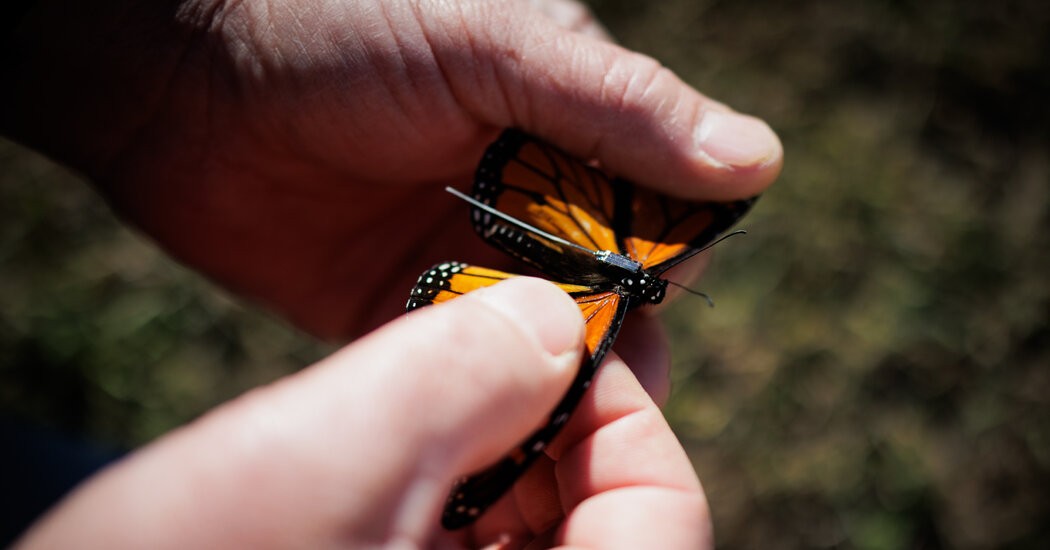For the first time in history, scientists are tracking individual monarch butterflies across thousands of miles, from as far north as Ontario to their overwintering grounds in central Mexico. This breakthrough, made possible by miniature, solar-powered radio tags, is poised to unlock critical insights into the poorly understood lives of migratory insects – many of which are now in steep decline.
The Technological Leap
The key to this unprecedented tracking is a tiny tag weighing just 60 milligrams and costing $200. Researchers have deployed over 400 tags this year, monitoring the butterflies’ journeys in real-time via a cellphone app developed by Cellular Tracking Technologies, a New Jersey-based company. To put it in perspective, each tagged monarch is carrying a weight equivalent to half a raisin with three uncooked grains of rice.
“There’s nothing that’s not amazing about this,” says Cheryl Schultz, a butterfly scientist at Washington State University. The ability to follow these insects’ movements could be vital in reversing their population decline, which has seen a 22% drop in butterfly abundance over the last two decades.
Beyond Stickers: A New Era of Tracking
Traditional monarch tracking relied on low-tech sticker tags, deployed since 1935. While Monarch Watch, founded by Dr. Orley Taylor, tags over 100,000 monarchs annually, fewer than 1% are ever recovered in the winter colonies. Even when recovered, these tags only reveal the butterfly’s starting point, leaving the long journey a mystery. The new radio tags fill this gap, providing continuous data on the butterflies’ routes, behaviors, and challenges.
What the Data Reveals
Early findings are already reshaping our understanding of monarch migration. Researchers are discovering that the journey is far more dramatic than previously thought, with many butterflies blown off course but utilizing their strong wing muscles and innate navigational abilities to recover.
“We can already see that a lot of things we thought we knew about how these insects move are oversimplifications,” says Dr. Taylor.
Monarchs navigate using two sophisticated systems: a sun-based compass and a backup magnetic compass that relies on ultraviolet light. However, how they locate the same isolated colonies year after year remains a mystery. Survival rates are low – less than one in four monarchs completes the journey, succumbing to winds, predators, or exhaustion.
The Bigger Picture: A Species Under Stress
The urgency of this research stems from the alarming decline in monarch populations. Winter colonies in Mexico, once numbering in the hundreds of millions in the 1990s, now rarely exceed 60 million. The West Coast population is even more vulnerable, with fewer than 10,000 seen last winter.
Experts attribute this decline to human influence: climate change reducing nectar sources, deforestation threatening colonies, and the widespread use of herbicides eliminating milkweed, the monarchs’ essential breeding habitat.
The Company Behind the Revolution
Cellular Tracking Technologies, a 36-employee company operating out of a New Jersey airport hangar, has pioneered the development of these miniature tracking devices. Founded by Michael Lanzone, the company has spent two decades refining the technology, now applicable to animals ranging from bumblebees to elephant seals.
First Results: Tracking Successes
Field tests began in September, with Canadian researchers tagging 30 monarchs in Ontario. The results were immediate: the app showed butterflies flying directly across Lake Erie and landing in cities like Cleveland.
One tagged female, designated LPM021, has flown over 425 miles beyond the known colonies, as of late November. Another monarch, JMU004, tagged in Virginia, completed the journey to the El Rosario colony in Mexico, arriving just hours ahead of a competitor from Kansas.
What’s Next: Staying in the Game
While the “race” to track the first monarch to Mexico was playful, the real goal is to understand the full migration process. Researchers believe the data will reveal how monarchs navigate, adapt to challenges, and ultimately survive.
“It’s not about winners and losers,” says Dr. Brown. “It’s about staying in the game.” The new tracking technology is a vital step in ensuring that these iconic insects remain a part of our world for generations to come
